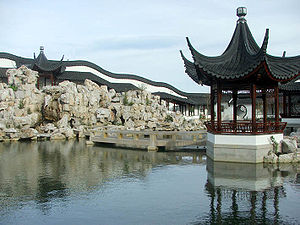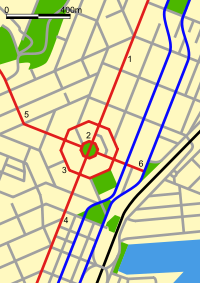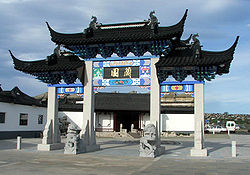
Dunedin Chinese Garden
Encyclopedia

Chinese garden
The Chinese garden, also known as a Chinese classical garden, is a style of landscape garden which has evolved for more than three thousand years, and which is inspired by Chinese literature, Chinese painting and Chinese philosophy...
, is located in the city of Dunedin
Dunedin
Dunedin is the second-largest city in the South Island of New Zealand, and the principal city of the Otago Region. It is considered to be one of the four main urban centres of New Zealand for historic, cultural, and geographic reasons. Dunedin was the largest city by territorial land area until...
in southern New Zealand
New Zealand
New Zealand is an island country in the south-western Pacific Ocean comprising two main landmasses and numerous smaller islands. The country is situated some east of Australia across the Tasman Sea, and roughly south of the Pacific island nations of New Caledonia, Fiji, and Tonga...
. It is sited next to the Otago Settlers' Museum close to the centre of the city and numerous other of the city's tourist attractions, including the Dunedin Railway Station
Dunedin Railway Station
Possibly the best-known building in the southern half of New Zealand's South Island, Dunedin Railway Station is a jewel in the country's architectural crown. Designed by George Troup, the station is the fourth building to have served as Dunedin's railway station...
and Queen's Gardens.
Name and commemoration
The garden is named Lan Yuan (蘭園). This was specifically chosen as it was considered to be significant on a number of levels. The character lan (蘭) is the third character in the Chinese name for New Zealand (niu xi lan, 紐西蘭), as well as being part of the name of the Yulan magnoliaMagnolia
Magnolia is a large genus of about 210 flowering plant species in the subfamily Magnolioideae of the family Magnoliaceae. It is named after French botanist Pierre Magnol....
, popularly thought of as the flower of Dunedin's sister city Shanghai
Shanghai
Shanghai is the largest city by population in China and the largest city proper in the world. It is one of the four province-level municipalities in the People's Republic of China, with a total population of over 23 million as of 2010...
[Note that, by itself, 蘭 means 'orchid']. In the booklet about the garden, it is called "The Garden of Enlightenment".
The garden commemorates the contribution of Chinese people to the history and culture of Dunedin. The city has long had a Chinese population, with many Cantonese people
Cantonese people
The Cantonese people are Han people whose ancestral homes are in Guangdong, China. The term "Cantonese people" would then be synonymous with the Bun Dei sub-ethnic group, and is sometimes known as Gwong Fu Jan for this narrower definition...
settling in and around Dunedin at the time of the Central Otago Gold Rush
Central Otago Gold Rush
The Central Otago Gold Rush was a gold rush that occurred during the 1860s in Central Otago, New Zealand...
in the 1860s, only some 15 years after the city was founded. Over two percent of Dunedin's population is of Chinese descent.
History and construction

Dunedin Railway Station
Possibly the best-known building in the southern half of New Zealand's South Island, Dunedin Railway Station is a jewel in the country's architectural crown. Designed by George Troup, the station is the fourth building to have served as Dunedin's railway station...
and the Otago Settlers' Museum.
Initially there was some concern that the site would prove too windy, and a small but vocal part of the Dunedin population was opposed to the garden's construction. Despite these concerns, foundation stones were laid by delegates from the gardens committee and Dunedin City Council, as well as the deputy mayor of Dunedin's Chinese sister-city, Shanghai
Shanghai
Shanghai is the largest city by population in China and the largest city proper in the world. It is one of the four province-level municipalities in the People's Republic of China, with a total population of over 23 million as of 2010...
, in March 1998. Much of the cost of the project was raised by public donations, though the New Zealand Government announced in 2006 that it would support the project to the tune of NZ$
New Zealand dollar
The New Zealand dollar is the currency of New Zealand. It also circulates in the Cook Islands , Niue, Tokelau, and the Pitcairn Islands. It is divided into 100 cents....
3.75 million.
The garden is an authentic Chinese Garden, having been created with the support of the Dunedin City Council and the Shanghai Municipal Government. It cost $7 million to construct. The garden is New Zealand's only authentic Chinese Garden and one of only three outside China - the first of its kind to be built in the southern hemisphere.
The design of the garden evolved over the course of eight years of planning to ensure functionality, accuracy, and authenticity. The garden is in the traditional yuanlin (園林) style, and was designed by Cao Yongkang of Shanghai Jiao Tong University
Shanghai Jiao Tong University
Shanghai Jiao Tong University or SJTU), sometimes referred to as Shanghai Jiaotong University , is a top public research university located in Shanghai, China. Shanghai Jiao Tong University is known as one of the oldest and most prestigious universities in China...
, Chen Ling of Tongji University
Tongji University
Tongji University , colloquially known as Tongji , located in Shanghai, has more than 30,000 students and 8,000 staff members . It offers degree programs at both undergraduate and postgraduate levels...
, and Tan Yufeng of Shanghai Museum
Shanghai Museum
The Shanghai Museum is a museum of ancient Chinese art, situated on the People's Square in the Huangpu District of Shanghai, People's Republic of China.-History:...
. They used as their basis the traditional gardens of the Jiangnan
Jiangnan
Jiangnan or Jiang Nan is a geographic area in China referring to lands immediately to the south of the lower reaches of the Yangtze River, including the southern part of the Yangtze Delta...
area, specifically because these gardens represent the apogee of Chinese garden style while at the same time being suitable for small sites in urban settings.
Construction and design was closely supervised by Shanghai Museum and architects from that city. Much of the garden was pre-fabricated in Shanghai on a site identical to that in Dunedin, then dismantled and re-assembled in New Zealand with the help of Shanghai artisans.
The garden was blessed in June 2008, in the presence of Prime Minister
Prime Minister of New Zealand
The Prime Minister of New Zealand is New Zealand's head of government consequent on being the leader of the party or coalition with majority support in the Parliament of New Zealand...
Helen Clark
Helen Clark
Helen Elizabeth Clark, ONZ is a New Zealand political figure who was the 37th Prime Minister of New Zealand for three consecutive terms from 1999 to 2008...
and Chinese ambassador Zhang Yuanyuan and opened to the public the following month. Prime Minister Clark returned to officially open the garden in September 2008.

Garden features
The Dunedin Chinese Garden is designed as a late MingMing Dynasty
The Ming Dynasty, also Empire of the Great Ming, was the ruling dynasty of China from 1368 to 1644, following the collapse of the Mongol-led Yuan Dynasty. The Ming, "one of the greatest eras of orderly government and social stability in human history", was the last dynasty in China ruled by ethnic...
/early Qing
Qing Dynasty
The Qing Dynasty was the last dynasty of China, ruling from 1644 to 1912 with a brief, abortive restoration in 1917. It was preceded by the Ming Dynasty and followed by the Republic of China....
Scholar’s garden, and is separated from the rest of the city by a four metre perimeter wall. It is centred on a large lake, around which are numerous structures: an Entrance hall, a square pavilion, a study, a climbing mountain half-pavilion and corridor, a tea house, and two-storey conference rooms. A zigzag bridge crosses the lake and connects with Chongyuan, a central pavilion. At the entrance to the garden is an elaborate Pai Lou archway.
Particular care was taken in the balance of movement and static elements, with the latter predominating . The most important vistas were to be those overlooking the central lake, with elements of movement and stasis linked by winding paths.
The garden's site covers an area of some 2500 square metres, and its construction included the pouring of 560 cubic metres of concrete, the use of over 280 tonnes of sand, 130 tonnes of hand-finished granite paving stones, as well as 380,000 hand-made roof tiles, and hand-constructed bricks and lattice-work. Trees planted around the outside of the garden walls will eventually shield the garden from many of the views and noises of the city which surrounds it. Almost 1000 tonnes of rock from Lake Taihu - an important feature of Chinese architecture for over 1000 years - was imported for the construction. Taihu faces environmental damage from excessive quarrying from the lake floor.

